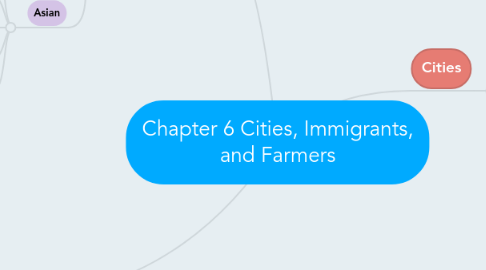
1. Farmers
1.1. The Problems of Farmers, 1870-1920
1.1.1. Agricultural Overproduction
1.1.2. The Scarcity of Money
1.1.3. High Shipping Costs
1.1.4. Farms Debt and the Cost of Money
1.1.5. Natural Disasters
1.2. Farmers Organize to Overcome Their Problems
1.2.1. The Grange Movement
1.2.2. Granger Laws
1.2.3. The Interstate Commerce Act (1887)
1.3. The Populist Party, 1892-1896
1.3.1. The Populist Platform of 1892
1.3.2. The Election of 1896
1.3.3. The Democratic Convention
1.3.4. The Election: McKinley versus Bryan
2. Immigration
2.1. European
2.1.1. From Southern and Eastern Europe
2.1.2. Spoke non-English languages
2.1.3. Most were Catholic or Jewish
2.1.4. Most were extremely poor
2.1.5. Most moved to ethnic "ghettos" in citites
2.1.6. Took low-paying jobs
2.2. Asian
2.2.1. From China and Japan
2.2.2. Spoke non-English languages
2.2.3. Faced discrimination in California and the West
2.2.4. Chinese Exclusion Act (1882)
2.2.5. Gentlemen's Agreement (1907)
3. Cities
3.1. The Reasons for Urbanization
3.1.1. Railroads and improved roads made it easier for people to move to cities.
3.1.2. Many people were attracted by the cultural opportunities and variety of city life.
3.1.3. The rise of factories and the needs of growing urban populations created more jobs.
3.2. Cities Face New Problems
3.2.1. Overcrowding and slums
3.2.2. Lacking of Sanitation and Pollution
3.2.3. Traffic Congestion
3.2.4. Vast Differences in Wealth
3.2.5. Political Corruption
3.2.6. The new lmmigrants
3.3. Important people
3.3.1. Tammy Hall
3.3.2. Boss Tweed
3.3.3. Thomas Nast

